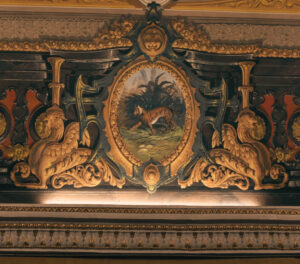 The Representative Halls have retained the structure and decorations chosen by Michelangelo Libertini, Noble of the Barons of S. Marco Lo Vecchio, when he purchased most of the Palazzo in 1871 from a relative, a member of the Maggiore di Santa Barbara family, descended from Marquess Barbaro Maggiore di Santa Barbara who completed the reconstruction of the Palazzo around 1725 by combining remnants of other palaces that survived the 1693 earthquake.
The Representative Halls have retained the structure and decorations chosen by Michelangelo Libertini, Noble of the Barons of S. Marco Lo Vecchio, when he purchased most of the Palazzo in 1871 from a relative, a member of the Maggiore di Santa Barbara family, descended from Marquess Barbaro Maggiore di Santa Barbara who completed the reconstruction of the Palazzo around 1725 by combining remnants of other palaces that survived the 1693 earthquake.
The Palazzo and the residence, which today can be considered a “palace within a palace,” combine a variety of styles ranging from the 16th-century layout of the courtyard, the Baroque staircase, to some parts clearly dating back to before 1000 A.D., such as the perimeter wall of the Castle Entrance, and the apse and four stone columns preceding the actual entrance to the halls, which date back to the 15th century.
The Yellow Hall and the Hall of Mirrors feature large canvases painted by Francesco Vaccaro, a member of the Bongiovanni-Vaccaro family of ceramists and painters that has been active in Caltagirone for 700 years, along with canvases enclosed in cartouches attributed to members of the same family.
The vaulted ceilings of the two halls are enriched with leaf and scroll decorations along with three-dimensional anthropomorphic figures.
Unique are the monumental jambs lacquered in white and gilded with pure gold, inspired by those of the Palace of Versailles, depicting leaf and fruit garlands, topped by the baronial crown.
Among the elements that distinguish the residence from other Representative Halls of Sicilian noble palaces are the custom-ordered Aubusson carpets from France for the individual halls, matching the predominant colors within them, and the hand-painted glass doors depicting a variety of colorful birds in all the halls except the Hall of Mirrors, where the glass doors feature the monogram ML (Michelangelo Libertini), enclosed by multicolored scrolls and foliage matching the ceiling decorations.
